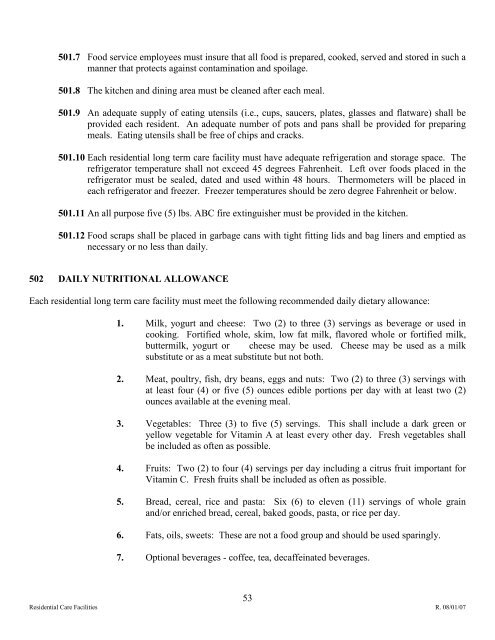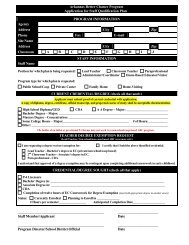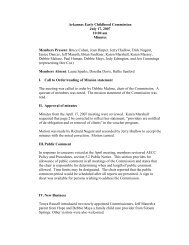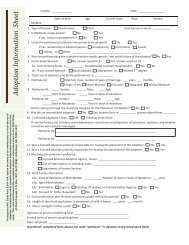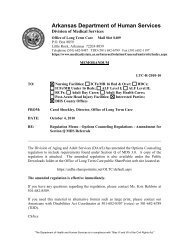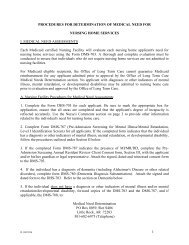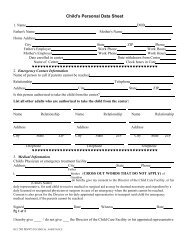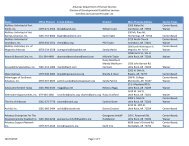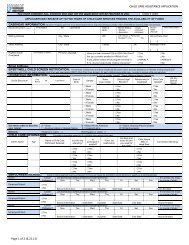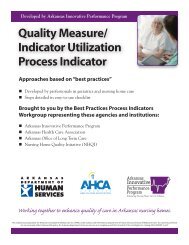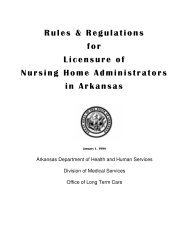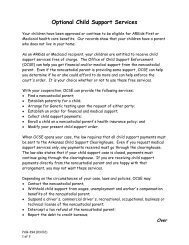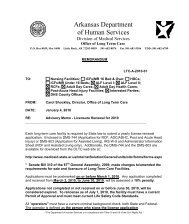AUTHORITY The following rules and regulations for the - Arkansas ...
AUTHORITY The following rules and regulations for the - Arkansas ...
AUTHORITY The following rules and regulations for the - Arkansas ...
Create successful ePaper yourself
Turn your PDF publications into a flip-book with our unique Google optimized e-Paper software.
501.7 Food service employees must insure that all food is prepared, cooked, served <strong>and</strong> stored in such a<br />
manner that protects against contamination <strong>and</strong> spoilage.<br />
501.8 <strong>The</strong> kitchen <strong>and</strong> dining area must be cleaned after each meal.<br />
501.9 An adequate supply of eating utensils (i.e., cups, saucers, plates, glasses <strong>and</strong> flatware) shall be<br />
provided each resident. An adequate number of pots <strong>and</strong> pans shall be provided <strong>for</strong> preparing<br />
meals. Eating utensils shall be free of chips <strong>and</strong> cracks.<br />
501.10 Each residential long term care facility must have adequate refrigeration <strong>and</strong> storage space. <strong>The</strong><br />
refrigerator temperature shall not exceed 45 degrees Fahrenheit. Left over foods placed in <strong>the</strong><br />
refrigerator must be sealed, dated <strong>and</strong> used within 48 hours. <strong>The</strong>rmometers will be placed in<br />
each refrigerator <strong>and</strong> freezer. Freezer temperatures should be zero degree Fahrenheit or below.<br />
501.11 An all purpose five (5) lbs. ABC fire extinguisher must be provided in <strong>the</strong> kitchen.<br />
501.12 Food scraps shall be placed in garbage cans with tight fitting lids <strong>and</strong> bag liners <strong>and</strong> emptied as<br />
necessary or no less than daily.<br />
502 DAILY NUTRITIONAL ALLOWANCE<br />
Each residential long term care facility must meet <strong>the</strong> <strong>following</strong> recommended daily dietary allowance:<br />
1. Milk, yogurt <strong>and</strong> cheese: Two (2) to three (3) servings as beverage or used in<br />
cooking. Fortified whole, skim, low fat milk, flavored whole or <strong>for</strong>tified milk,<br />
buttermilk, yogurt or cheese may be used. Cheese may be used as a milk<br />
substitute or as a meat substitute but not both.<br />
2. Meat, poultry, fish, dry beans, eggs <strong>and</strong> nuts: Two (2) to three (3) servings with<br />
at least four (4) or five (5) ounces edible portions per day with at least two (2)<br />
ounces available at <strong>the</strong> evening meal.<br />
3. Vegetables: Three (3) to five (5) servings. This shall include a dark green or<br />
yellow vegetable <strong>for</strong> Vitamin A at least every o<strong>the</strong>r day. Fresh vegetables shall<br />
be included as often as possible.<br />
4. Fruits: Two (2) to four (4) servings per day including a citrus fruit important <strong>for</strong><br />
Vitamin C. Fresh fruits shall be included as often as possible.<br />
5. Bread, cereal, rice <strong>and</strong> pasta: Six (6) to eleven (11) servings of whole grain<br />
<strong>and</strong>/or enriched bread, cereal, baked goods, pasta, or rice per day.<br />
6. Fats, oils, sweets: <strong>The</strong>se are not a food group <strong>and</strong> should be used sparingly.<br />
7. Optional beverages - coffee, tea, decaffeinated beverages.<br />
53<br />
Residential Care Facilities R. 08/01/07


